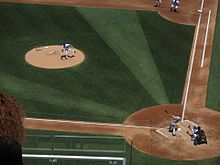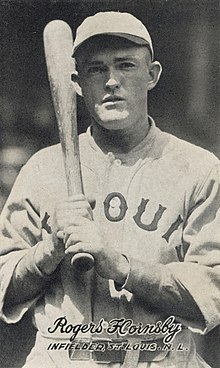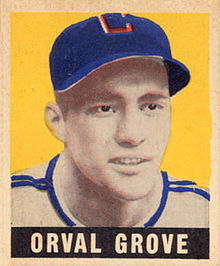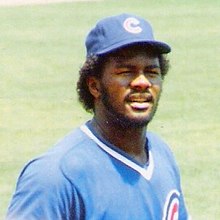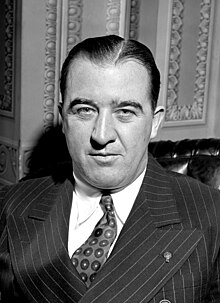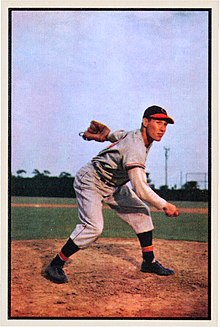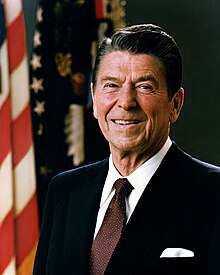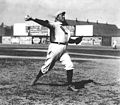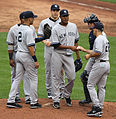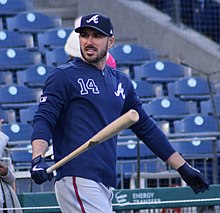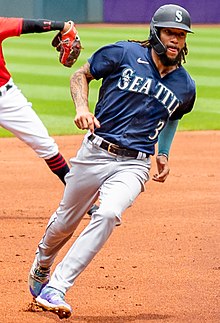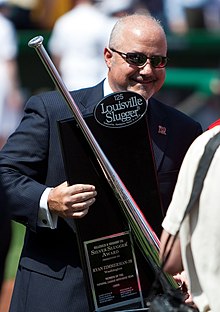Portal:Baseball
Portal maintenance status: (June 2018)
|
| Main page | Content, Categories & Topics | WikiProjects & Things you can do |
The Baseball Portal
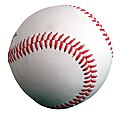
Baseball is a bat-and-ball sport played between two teams of nine players each, taking turns batting and fielding. The game occurs over the course of several plays, with each play generally beginning when a player on the fielding team, called the pitcher, throws a ball that a player on the batting team, called the batter, tries to hit with a bat. The objective of the offensive team (batting team) is to hit the ball into the field of play, away from the other team's players, allowing its players to run the bases, having them advance counter-clockwise around four bases to score what are called "runs". The objective of the defensive team (referred to as the fielding team) is to prevent batters from becoming runners, and to prevent runners advancing around the bases. A run is scored when a runner legally advances around the bases in order and touches home plate (the place where the player started as a batter).
The opposing teams switch back and forth between batting and fielding; the batting team's turn to bat is over once the fielding team records three outs. One turn batting for each team constitutes an inning. A game is usually composed of nine innings, and the team with the greater number of runs at the end of the game wins. Most games end after the ninth inning, but if scores are tied at that point, extra innings are usually played. Baseball has no game clock, though some competitions feature pace-of-play regulations such as the pitch clock to shorten game time.
Baseball evolved from older bat-and-ball games already being played in England by the mid-18th century. This game was brought by immigrants to North America, where the modern version developed. Baseball's American origins, as well as its reputation as a source of escapism during troubled points in American history such as the American Civil War and the Great Depression, have led the sport to receive the moniker of "America's Pastime"; since the late 19th century, it has been unofficially recognized as the national sport of the United States, though in modern times is considered less popular than other sports, such as American football. In addition to North America, baseball spread throughout the rest of the Americas and the Asia–Pacific in the 19th and 20th centuries, and is now considered the most popular sport in parts of Central and South America, the Caribbean, and East Asia, particularly in Japan, South Korea, and Taiwan. (Full article...)
 Featured articles - load new batch
Featured articles - load new batch
-
Image 1
Herschel Greer Stadium was a Minor League Baseball park in Nashville, Tennessee, on the grounds of Fort Negley, an American Civil War fortification, approximately two mi (3.2 km) south of the city's downtown district. The facility closed at the end of the 2014 baseball season and remained deserted for over four years until its demolition in 2019. Following an archaeological survey, the land is expected to be reincorporated into Fort Negley Park.
Greer was opened in 1978 for the Nashville Sounds, an expansion franchise of the Double-A Southern League who moved to the Triple-A American Association in 1985 and to the Triple-A Pacific Coast League in 1998. The stadium played host to the team until 2014. The subject of numerous upgrades and repairs to maintain its functionality, Greer became one of the oldest stadiums used by a Triple-A team and had fallen well below professional baseball's standards for a stadium at that class level by the end of its use. For over a decade, the Sounds attempted to secure agreements with the Metropolitan Government of Nashville and Davidson County for a new ballpark to replace Greer, eventually resulting in the construction of First Tennessee Park, which became the Sounds' new home in 2015. (Full article...) -
Image 2
Rogers Hornsby (April 27, 1896 – January 5, 1963), nicknamed "the Rajah", was an American baseball infielder, manager, and coach who played 23 seasons in Major League Baseball (MLB). He played for the St. Louis Cardinals (1915–1926, 1933), New York Giants (1927), Boston Braves (1928), Chicago Cubs (1929–1932), and St. Louis Browns (1933–1937). He was named the National League (NL)'s Most Valuable Player (MVP) twice, and was a member of one World Series championship team.
Born in Winters, Texas, and raised in Fort Worth, Texas, Hornsby played for several semi-professional and minor league teams. In 1915, he began his major league career with the St. Louis Cardinals and remained with the team for 12 seasons. During this period, Hornsby won his first MVP Award and the Cardinals won the 1926 World Series. After that season, he spent one season with the New York Giants and another with the Boston Braves before being traded to the Chicago Cubs. He played with the Cubs for four years and won his second MVP Award before the team released him in 1932. Hornsby re-signed with the Cardinals in 1933, but was released partway through the season, effectively ending his career as a full-time player. He was picked up by the St. Louis Browns and remained there until his final season in 1937, though he made only 67 appearances for them as a player. From 1925 to 1937, Hornsby was intermittently a player-manager. After retiring as a player, he managed the Browns in 1952 and the Cincinnati Reds from 1952 to 1953. (Full article...) -
Image 3Adenhart pitching for the Salt Lake Bees in 2008
Nicholas James Adenhart (August 24, 1986 – April 9, 2009) was an American right-handed baseball starting pitcher who played parts of two seasons in Major League Baseball (MLB) for the Los Angeles Angels of Anaheim. In just four career games, Adenhart pitched 18 innings and posted a win-loss record of 1–0.
A graduate of Williamsport High School, Adenhart was highly touted as a high school prospect until an injury in his final game required Tommy John surgery. The Angels drafted him in the 14th round of the 2004 Major League Baseball draft, and began playing in their minor league system after the surgery was a success. He spent three full seasons in the minor leagues before making his major league debut on May 1, 2008. After appearing in three games, Adenhart spent the rest of 2008 in the minor leagues developing his skills, and in 2009 he earned a spot in the Angels' starting rotation. (Full article...) -
Image 4
Orval Leroy Grove (August 29, 1919 – April 20, 1992) was an American professional baseball pitcher in Major League Baseball who played for ten seasons in the American League with the Chicago White Sox. In 207 career games, Grove pitched 1,176 innings and posted a win–loss record of 63–73, with 66 complete games, 11 shutouts, and a 3.78 earned run average (ERA).
The only freshman on the Proviso Township High School varsity baseball team, Grove's pitching ability attracted the attention of the White Sox. After signing with the team in 1937, Grove moved between the major leagues and minor leagues for a few seasons until 1943, when he found a solid place in the White Sox's pitching rotation. Grove had a career-year in 1943, finishing the season with career-bests in ERA, wins, and complete games; in 1944, he made his only All-Star appearance. (Full article...) -
Image 5
Jack Roosevelt Robinson (January 31, 1919 – October 24, 1972) was an American professional baseball player who became the first African-American to play in Major League Baseball (MLB) in the modern era. Robinson broke the color line when he started at first base for the Brooklyn Dodgers on April 15, 1947. The Dodgers signing Robinson heralded the end of racial segregation in professional baseball, which had relegated black players to the Negro leagues since the 1880s.
Born in Cairo, Georgia, Robinson was raised in Pasadena, California. A four-sport student athlete at Pasadena Junior College and the University of California, Los Angeles, he was better known for football than he was for baseball, becoming a star college player with the UCLA Bruins football team. Following his college career, Robinson was drafted for service during World War II but was court-martialed for refusing to sit at the back of a segregated Army bus, eventually being honorably discharged. Afterwards, he signed with the Kansas City Monarchs of the Negro leagues, where he caught the eye of Branch Rickey, general manager of the Brooklyn Dodgers, who thought he would be the perfect candidate for breaking the color line in MLB. (Full article...) -
Image 6
Lee Arthur Smith (born December 4, 1957) is an American former professional baseball pitcher who played 18 years in Major League Baseball (MLB) for eight teams. Serving mostly as a relief pitcher during his career, he was a dominant closer, was the first pitcher to reach 400 saves, and held the major league record for career saves from 1993 until 2006, when Trevor Hoffman passed his total of 478. He was elected to the National Baseball Hall of Fame as part of the class of 2019 by the Today's Game Era Committee.
A native of Jamestown in Bienville Parish in north Louisiana, Smith was scouted by Buck O'Neil and was selected by the Chicago Cubs in the 1975 MLB draft. Smith was an intimidating figure on the pitcher's mound at 6 feet 6 inches (1.98 m) and 265 pounds (120 kg) with a 95-mile-per-hour (150 km/h) fastball. In 1991, he set a National League (NL) record with 47 saves for the St. Louis Cardinals, and was runner-up for the league's Cy Young Award; it was the second of three times Smith led the NL in saves, and he later led the American League (AL) in saves once. When he retired, he held the major league record for career games finished (802) and was third in games pitched (1,022). He holds the Cubs' team record for career saves (180), and held the same record for the Cardinals (160) until 2006. (Full article...) -
Image 7
Michael Jeffrey Jordan (born February 17, 1963), also known by his initials MJ, is an American businessman and former professional basketball player. He played 15 seasons in the National Basketball Association (NBA) between 1984 and 2003, winning six NBA championships with the Chicago Bulls. He was integral in popularizing basketball and the NBA around the world in the 1980s and 1990s, becoming a global cultural icon. His profile on the NBA website states, "By acclamation, Michael Jordan is the greatest basketball player of all time."
Jordan played college basketball with the North Carolina Tar Heels. As a freshman, he was a member of the Tar Heels' national championship team in 1982. Jordan joined the Bulls in 1984 as the third overall draft pick and quickly emerged as a league star, entertaining crowds with his prolific scoring while gaining a reputation as one of the best defensive players. His leaping ability, demonstrated by performing slam dunks from the free-throw line in Slam Dunk Contests, earned him the nicknames "Air Jordan" and "His Airness". Jordan won his first NBA title with the Bulls in 1991 and followed that achievement with titles in 1992 and 1993, securing a three-peat. Citing physical and mental exhaustion from basketball and superstardom, Jordan abruptly retired from basketball before the 1993–94 NBA season to play Minor League Baseball in the Chicago White Sox organization. He returned to the Bulls in March 1995 and led them to three more championships in 1996, 1997, and 1998, as well as a then-record 72 regular season wins in the 1995–96 NBA season. Jordan retired for the second time in January 1999, returning for two more NBA seasons from 2001 to 2003 as a member of the Washington Wizards. He was selected to play for the United States national team during his college and NBA careers, winning four gold medals—at the 1983 Pan American Games, 1984 Summer Olympics, 1992 Tournament of the Americas and 1992 Summer Olympics—while also being undefeated. (Full article...) -
Image 8
Albert Benjamin "Happy" Chandler Sr. (July 14, 1898 – June 15, 1991) was an American politician from Kentucky. He represented Kentucky in the U.S. Senate and served as its 44th and 49th governor. Aside from his political positions, he also served as the second commissioner of baseball from 1945 to 1951 and was inducted into the Baseball Hall of Fame in 1982. His grandson, Ben Chandler, later served as congressman for Kentucky's Sixth District.
A multi-sport athlete during his college days at Transylvania College, Chandler briefly considered a career in professional baseball before deciding to pursue a law degree. After graduation, he entered politics and was elected as a Democrat to the Kentucky Senate in 1929. Two years later, he was elected lieutenant governor, serving under Governor Ruby Laffoon. Chandler and Laffoon disagreed on the issue of instituting a state sales tax and when Chandler, the presiding officer in the state senate, worked to block the legislation, Laffoon's allies in the General Assembly stripped him of many of his statutory powers. The tax then passed by a narrow margin. Knowing that Laffoon would try to select his own successor at the Democratic nominating convention, Chandler waited until Laffoon left the state—leaving Chandler as acting governor—and called the legislature into session to enact a mandatory primary election bill. The bill passed, and in the ensuing primary, Chandler defeated Laffoon's choice, Thomas Rhea. He then went on to defeat Republican King Swope by the largest margin of victory for a Kentucky gubernatorial race at that time. As governor, Chandler oversaw the repeal of the sales tax, replacing the lost revenue with new excise taxes and the state's first income tax. He also enacted a major reorganization of state government, realizing significant savings for the state. He used these savings to pay off the state debt and improve the state's education and transportation systems. (Full article...) -
Image 9
Arthur Joseph Houtteman (August 7, 1927 – May 6, 2003) was an American right-handed pitcher in Major League Baseball who played for 12 seasons in the American League with the Detroit Tigers, Cleveland Indians and Baltimore Orioles. In 325 career games, Houtteman pitched 1,555 innings and posted a win–loss record of 87–91, with 78 complete games, 14 shutouts, and a 4.14 earned run average (ERA).
Known on the sandlot for his pitching motion, Houtteman was signed by scout Wish Egan in 1945 at 17 years of age. He was recruited by major league teams, and joined a Tigers pitching staff that had lost players to injuries and World War II. After moving between the major and minor leagues over the next few years, he was nearly killed in an automobile accident just before the 1949 season. Houtteman rebounded from his injuries and went on to win 15 games that season and made his only All-Star appearance in the following year. (Full article...) -
Image 10
Harmon Clayton Killebrew Jr. (/ˈkɪlɪbruː/; June 29, 1936 – May 17, 2011), nicknamed "the Killer" and "Hammerin' Harmon", was an American professional baseball first baseman, third baseman, and left fielder. He spent most of his 22-year career in Major League Baseball (MLB) with the Minnesota Twins. A prolific power hitter, Killebrew had the fifth-most home runs in major league history at the time of his retirement. He was second only to Babe Ruth in American League (AL) home runs, and was the AL career leader in home runs by a right-handed batter. Killebrew was inducted into the National Baseball Hall of Fame in 1984.
Killebrew was 5-foot-11-inch (180 cm) tall and 213 pounds (97 kg). His compact swing generated tremendous power and made him one of the most feared power hitters of the 1960s, when he hit at least 40 home runs per season eight times. In total Killebrew led the league six times in home runs and three times in RBIs, and was named to 13 All-Star teams. In 1965, he played in the World Series with the Twins, who lost to the Los Angeles Dodgers. His finest season was 1969, when he hit 49 home runs, recorded 140 RBIs and won the AL Most Valuable Player Award while helping lead the Twins to the AL West pennant. (Full article...) -
Image 11William Derrick Bates (born December 7, 1963) is an American former professional baseball second baseman and pinch runner who played in Major League Baseball (MLB) for the Milwaukee Brewers and the Cincinnati Reds. In 29 career games, Bates had a batting average of .125 with six hits, two runs batted in (RBI), 11 runs, and eight stolen bases. Though his defensive position was at second base, the Reds primarily used Bates as a pinch runner. After he scored the winning run in Game 2 of the 1990 World Series, Bates never played in MLB again.
Born in Houston, Bates attended the University of Texas and, in his freshman season, won the 1983 College World Series as a part of the Texas Longhorns baseball team. For the next two seasons, Bates was named to the College Baseball All-America Team, a team composed of the best collegiate baseball athletes in America. Drafted by Milwaukee in the fourth round of the 1985 MLB draft, he rose through the Brewers' farm system helping several of his minor league teams win their respective league titles. He made his MLB debut in 1989, after Milwaukee's starting second baseman Jim Gantner was injured. A trade in 1990 sent Bates to Cincinnati, where the Reds used him primarily as a pinch runner at the end of the regular season and into the postseason. Facing the Oakland Athletics in the World Series, Bates reached base on a pinch hit single against Dennis Eckersley and later scored the winning run in Game 2 as the Reds swept the Athletics four games to none. Following the World Series championship, the Reds re-signed Bates on a one-year contract, and he played for their Triple-A team. He spent the next year with the Chicago Cubs Triple-A affiliate, and last played exhibition baseball in 1995. After retiring, he worked as an equipment supplier in the oil and gas industry in Houston. (Full article...) -
Image 12
Robert William Andrew Feller (November 3, 1918 – December 15, 2010), nicknamed "the Heater from Van Meter", "Bullet Bob", and "Rapid Robert", was an American baseball pitcher who played 18 seasons in Major League Baseball (MLB) for the Cleveland Indians between 1936 and 1956. In a career spanning 570 games, Feller pitched 3,827 innings and posted a win–loss record of 266–162, with 279 complete games, 44 shutouts, and a 3.25 earned run average (ERA). His career 2,581 strikeouts were third all-time upon his retirement.
A prodigy who bypassed baseball's minor leagues, Feller made his debut with the Indians at the age of 17. His career was interrupted by four years of military service (1942–1945) as a United States Navy Chief Petty Officer aboard USS Alabama during World War II. Feller became the first pitcher to win 24 games in a season before the age of 21. He threw no-hitters in 1940, 1946, and 1951, and 12 one-hitters, both records at his retirement. He helped the Indians win a World Series title in 1948 and an American League-record 111 wins and the pennant in 1954. Feller led the American League in wins six times and in strikeouts seven times. In 1946 he recorded 348 strikeouts, the most since 1904 and then believed to be a record. (Full article...) -
Image 13
Daniel Lucius "Doc" Adams (November 1, 1814 – January 3, 1899) was an American baseball player and executive who is regarded by historians as an important figure in the sport's early years. For most of his career he was a member of the New York Knickerbockers. He first played for the New York Base Ball Club in 1840 and started his Knickerbockers career five years later, continuing to play for the club into his forties and to take part in inter-squad practice games and matches against opposing teams. Researchers have called Adams the creator of the shortstop position, which he used to field short throws from outfielders. In addition to his playing career, Adams manufactured baseballs and oversaw bat production; he also occasionally acted as an umpire.
From 1847 to 1861, the Knickerbockers selected Adams as their president six times, and as a vice president, treasurer, or director in six other years. As president of the club, Adams was an advocate of rule changes in baseball that resulted in nine-man teams and nine-inning games. When the National Association of Base Ball Players (NABBP) was formed in 1858, he led the rules and regulations committee of the new organization. In his role, Adams ruled that the fields' bases should be 90 feet (27 m) apart, the modern distance, and supported the elimination of the "bound rule", which allowed for balls caught after one bounce to be recorded as outs. He resigned from his positions with the Knickerbockers and NABBP in 1862. Adams' contributions in creating baseball's rules went largely unrecognized for decades after his 1899 death, but in 1980 a letter about him appeared in The New York Times; by 1993, researcher John Thorn had written about Adams' role. Other historians have given him credit for helping to develop the sport, and Thorn has called Adams "first among the Fathers of Baseball". (Full article...) -
Image 14
Robert William Meusel (July 19, 1896 – November 28, 1977) was an American baseball left and right fielder who played in Major League Baseball (MLB) for eleven seasons from 1920 through 1930, all but the last for the New York Yankees. He was best known as a member of the Yankees' championship teams of the 1920s, nicknamed "Murderers' Row", during which time the team won its first six American League (AL) pennants and first three World Series titles.
Meusel, noted for his strong outfield throwing arm, batted fifth behind Baseball Hall of Famers Babe Ruth and Lou Gehrig. In 1925, he became the second Yankee, after Ruth, to lead the AL in home runs (33), runs batted in (138) and extra base hits (79). Nicknamed "Long Bob" because of his 6-foot, 3 inch (1.91 m) stature, Meusel batted .313 or better in seven of his first eight seasons, finishing with a .309 career average; his 1,009 RBI during the 1920s were the fourth most by any major leaguer, and trailed only Harry Heilmann's total of 1,131 among AL right-handed hitters. Meusel ended his career in 1930 with the Cincinnati Reds. He hit for the cycle three times, and was the second of six major leaguers to accomplish this feat as many as three times during a career. (Full article...) -
Image 15
Ronald Wilson Reagan (February 6, 1911 – June 5, 2004) was an American politician and actor who served as the 40th president of the United States from 1981 to 1989. He was a member of the Republican Party and became an important figure in the American conservative movement. His presidency is known as the Reagan era.
Born in Illinois, Reagan graduated from Eureka College in 1932 and was hired the next year as a sports broadcaster in Iowa. In 1937, he moved to California where he became a well-known film actor. During his acting career, Reagan was president of the Screen Actors Guild twice, from 1947 to 1952 and from 1959 to 1960. In the 1950s, he hosted General Electric Theater and worked as a motivational speaker for General Electric. Reagan's "A Time for Choosing" speech during the 1964 presidential election launched his rise as a leading conservative figure. After being elected governor of California in 1966, he raised state taxes, turned the state budget deficit into a surplus and implemented harsh crackdowns on university protests. Following his loss to Gerald Ford in the 1976 Republican Party presidential primaries, Reagan won the Republican Party's nomination and then a landslide victory over President Jimmy Carter in the 1980 presidential election. (Full article...)
General images - load new batch
-
Image 1Cy Young—the holder of many major league career marks, including wins and innings pitched, as well as losses—in 1908. MLB's annual awards for the best pitcher in each league are named for Young. (from Baseball)
-
Image 2A batter follows through after swinging at a pitched ball. (from Baseball rules)
-
Image 3Baseball games sometimes end in a walk-off home run, with the batting team usually gathering at home plate to celebrate the scoring of the winning run(s). (from Baseball rules)
-
Image 4Sadaharu Oh managing the Japan national team in the 2006 World Baseball Classic. Playing for the Central League's Yomiuri Giants (1959–80), Oh set the professional world record for home runs. (from Baseball)
-
Image 5The NL champion New York Giants baseball team, 1913. Fred Merkle, sixth in line, had committed a baserunning gaffe in a crucial 1908 game that became famous as Merkle's Boner. (from History of baseball)
-
Image 6A first baseman receives a pickoff throw, as the runner dives back to first base. (from Baseball)
-
Image 8Pesäpallo, a Finnish variation of baseball, was invented by Lauri "Tahko" Pihkala in the 1920s, and after that, it has changed with the times and grown in popularity. Picture of Pesäpallo match in 1958 in Jyväskylä, Finland. (from Baseball)
-
Image 11By the 1860s Civil War, baseball (bottom) had overtaken its fellow bat-and-ball sport cricket (top) in popularity within the United States. (from History of baseball)
-
Image 12A game from the Cantigas de Santa Maria, c. 1280, involving tossing a ball, hitting it with a stick and competing with others to catch it (from History of baseball)
-
Image 13Diagram of a baseball field Diamond may refer to the square area defined by the four bases or to the entire playing field. The dimensions given are for professional and professional-style games. Children often play on smaller fields. (from Baseball)
-
Image 14Diagram indicating the standard layot of positions (from Baseball)
-
Image 16Jackie Robinson in 1945, with the era's Kansas City Royals, a barnstorming squad associated with the Negro American League's Kansas City Monarchs (from Baseball)
-
Image 17Rickey Henderson—the major leagues' all-time leader in runs and stolen bases—stealing third base in a 1988 game (from Baseball)
-
Image 18Baserunners generally stand a short distance away from their base between pitches, preparing themselves to either go back or steal the next base. (from Baseball rules)
-
Image 19Cover of Official Base Ball Rules, 1921 edition, used by the American League and National League (from Baseball rules)
-
Image 20Japanese-Americans spectating a World War II-era game while in an internment camp. America's ties to immigrants and to Japan have been deeply shaped by a shared baseball heritage. (from History of baseball)
-
Image 21Sadaharu Oh managing the Japan national team in the 2006 World Baseball Classic. Playing for the Central League's Yomiuri Giants (1959–80), Oh set the professional world record for home runs with 868. (from History of baseball)
-
Image 22Jackie Robinson in 1945, with the era's Kansas City Royals, a barnstorming squad associated with the Negro American League's Kansas City Monarchs (from History of baseball)
-
Image 23A runner sliding into home plate and scoring. (from Baseball)
-
Image 25Pick-off attempt on runner (in red) at first base (from Baseball rules)
-
Image 26Pitchers are generally substituted during mound visits (team gatherings at the pitcher's mound). (from Baseball rules)
-
Image 271906 World Series, infielders playing "in" for the expected bunt and the possible play at the plate with the bases loaded (from Baseball rules)
-
Image 28In May 2010, the Philadelphia Phillies' Roy Halladay pitched the 20th major league perfect game. That October, he pitched only the second no-hitter in MLB postseason history. (from History of baseball)
-
Image 30The typical motion of a right-handed pitcher (from Baseball rules)
-
Image 31The strike zone, which determines the outcome of most pitches, varies in vertical length depending on the batter's typical height while swinging. (from Baseball rules)
-
Image 32Two players on the baseball team of Tokyo, Japan's Waseda University in 1921 (from Baseball)
-
Image 33A well-worn baseball (from Baseball)
-
Image 34Fenway Park, home of the Boston Red Sox. The Green Monster is visible beyond the playing field on the left. (from Baseball)
-
Image 37The standard fielding positions (from Baseball rules)
-
Image 39A New York Yankees batter (Andruw Jones) and a Boston Red Sox catcher at Fenway Park (from Baseball)
-
Image 40Alexander Cartwright, father of modern baseball (from History of baseball)
-
Image 41A pitcher handing off the ball after being taken out of the game during a mound meeting. (from Baseball)
-
Image 42The strike zone determines the result of most pitches, and varies in vertical length for each batter. (from Baseball)
-
Image 432013 World Baseball Classic championship match between the Dominican Republic and Puerto Rico, March 20, 2013 (from Baseball)
-
Image 44An Afghan girl playing baseball in August 2002 (from Baseball)
-
Image 45The American Tobacco Company's line of baseball cards featured shortstop Honus Wagner of the Pittsburgh Pirates from 1909 to 1911. In 2007, the card shown here sold for $2.8 million. (from Baseball)
 Good articles - load new batch
Good articles - load new batch
-
Image 1
Matthew Ryan Joyce (born August 3, 1984) is an American former professional baseball outfielder, who played 14 seasons in Major League Baseball (MLB). Between 2008 and 2021, he played for eight MLB teams, most notably the Tampa Bay Rays, with whom he was named an MLB All-Star in 2011.
Raised by a single father in Tampa, Florida, Joyce frequently attended Rays games at Tropicana Field as a child. The Detroit Tigers attended an exhibition game that Joyce played with Florida Southern College and selected him in the 12th round of the 2005 MLB Draft. Joyce debuted with the Tigers in 2008 and was traded to the Rays the following season. After five years in St. Petersburg, Florida, Joyce was traded to the Los Angeles Angels, where his performance suffered after a 2015 concussion. (Full article...) -
Image 2
Eric Lynn Hacker (born March 26, 1983) is an American former professional baseball pitcher. Hacker stands 6 feet 1 inch (1.85 m) and weighs 230 pounds (100 kg). He throws right-handed but is a switch hitter. He played in Major League Baseball (MLB) for the Pittsburgh Pirates, Minnesota Twins, and San Francisco Giants, and in the KBO League for the NC Dinos and Nexen Heroes. He throws a fastball, a slider, a curveball, and a changeup.
Hacker was drafted out of Duncanville High School by the New York Yankees in 2002. He pitched in their minor league system from 2002 to 2009 (missing 2004 and 2006 with injuries) before getting traded to the Pirates. He made his major league debut with Pittsburgh on September 22, 2009, and pitched in three games for them that season. He signed with the Giants in the offseason and spent the entire 2010 season in the minor leagues. In 2011, he signed with the Twins and appeared in two games with them. He signed with San Francisco in 2012 and made his first career start in the majors, recording a loss. He also pitched three games in relief for the Giants that year. (Full article...) -
Image 3
Oliver Wall Kuhn (August 14, 1898 – October 8, 1968), nicknamed "Doc Kuhn", was an American football, baseball and basketball player for the Vanderbilt University Commodores and later a prominent businessman of Tampa, Florida. As a college football quarterback, Kuhn led Vanderbilt to three consecutive Southern titles in 1921, 1922, and 1923 – the most-recent conference titles for Vanderbilt football. In 1922, Vanderbilt tied Michigan at the dedication of Dudley Field, and Kuhn was picked for Walter Camp's list of names worthy of mention and Billy Evans' All-America "National Honor Roll."
During his senior year, Kuhn was the captain of Vanderbilt's football and basketball teams and received the Porter Cup, awarded to Vanderbilt's best all-around athlete. Kuhn played guard on the basketball team and was a shortstop on the baseball team which won a 1921 conference championship. He was selected All-Southern in baseball in 1921 and 1922. (Full article...) -
Image 4Crawford with the Seattle Mariners in 2021
John Paul Crawford (born January 11, 1995) is an American professional baseball shortstop for the Seattle Mariners of Major League Baseball (MLB).
Growing up in Lakewood, California, Crawford attended Lakewood High School, where he achieved recognition for his athletic performance. Crawford was considered one of the nation's best teenage baseball players. The 16th pick overall in the 2013 MLB draft, Crawford began his career with the Philadelphia Phillies as an exceptional defensive infielder and was considered the organization's top prospect for much of his rise through their minor league system. He was promoted to the major league ball club, in 2017, playing at shortstop and third base. Prior to the 2019 season, Crawford was traded to the Mariners. (Full article...) -
Image 5The world champion Philadelphia Phillies honored at the White House after their 2008 World Series victory
The Philadelphia Phillies' 2008 season was the 126th in the history of the franchise. The team finished with a regular season record of 92–70, first in the National League East. In the postseason, the Phillies won the World Series; this was the first major sports championship for Philadelphia since the 76ers swept the 1983 NBA Finals. During the season, they were managed by Charlie Manuel. To date, this is the most recent season the Phillies won the World Series.
The Phillies opened the season by posting their first winning April since 2003. They also scored 60 runs over 5 games in late May in a sweep over the Colorado Rockies and accrued a 14–4 record over 18 games entering the month of June. The Phillies' performance declined in late June, but they improved after the All-Star break, going 9–6 immediately following the midseason hiatus. Closer Brad Lidge earned eight saves in those games, and did not blow a save throughout the season and the postseason. Philadelphia traded sweeps with the Los Angeles Dodgers in August and went 13–3 in their last 16 games, taking advantage of a late swoon by the New York Mets for the second year in a row to capture the division crown. The team won its position in the playoffs after its second consecutive East Division title. The Phillies also posted the best road record in the National League, at 44–37. (Full article...) -
Image 6
Neifi Neftali Pérez (/ˈneɪfi, ˈnɛfi/; Spanish: [ˈnejfi]; born June 2, 1973) is a Dominican former Major League baseball player. He was a switch hitter who threw right-handed. During his career, he played with the Colorado Rockies, Kansas City Royals, San Francisco Giants, Chicago Cubs, and Detroit Tigers.
Pérez was originally signed by the Colorado Rockies in 1992. Frequently praised for his defensive skills, Pérez reached the major leagues in 1996 and became the Rockies' shortstop for good in 1997. Over the next three years, he scarcely missed a game and won a Gold Glove in 2000. In 2001, he was traded to the Kansas City Royals, where he also played in 2002. The trade proved to be unpopular with both teams, and Pérez joined the San Francisco Giants for 2003 and 2004. He lost his starting job during the 2004 season and was released during that year. Pérez then signed with the Chicago Cubs, whom he finished the season with and spent most of the next two years with. He was the Cubs' starting shortstop in 2005 but was used as a reserve player in 2006 before getting traded to the Detroit Tigers during the year. He finished his career in 2007 with the Tigers. As a Tiger, he turned a double play which saved Justin Verlander's no-hitter, but he also had a series of positive tests for amphetamines which effectively ended his career. (Full article...) -
Image 7Henry Gorham Crisp (December 10, 1896 – January 23, 1970) was an American football, basketball, baseball and track coach and college athletics administrator. In spite of an accident when he was 13 years old that resulted in the loss of his right hand, Crisp went on to letter in football, basketball and track at both Hampden–Sydney College and Virginia Tech – then known primarily as VPI.
After completing his collegiate career, Crisp began his long coaching career at the University of Alabama. There he served as the head basketball coach (1924–1942, 1945–1946), baseball coach (1928), track coach (1921–1927), as a line coach with the football team (1921–1941, 1945, 1950–1957) and as athletic director (1930–1940, 1954–1957). Crisp also served as an assistant and interim head coach with the Miami Seahawks (1946) and as a line coach at Tulane (1947–1949). (Full article...) -
Image 8

Jerome Matthew "Jerry" Dybzinski (born July 7, 1955) is an American former professional baseball shortstop. He played in Major League Baseball (MLB) for the Cleveland Indians, Chicago White Sox, and Pittsburgh Pirates. In 468 career games, Dybzinski recorded a batting average of .234 and accumulated three home runs and 93 runs batted in (RBI).
Born in Cleveland, Dybzinski played college baseball at Cleveland State University and was drafted by the Cleveland Indians in 1977. He spent the next four years in the minor leagues before making the major league roster in 1980. After three seasons with the Indians, he was traded to the Chicago White Sox in 1983, where he was part of the team's playoff run. Dybzinski spent two seasons with the White Sox before being released. He spent the next two seasons with the Pittsburgh Pirates and Seattle Mariners organizations before retiring from professional baseball in 1986. (Full article...) -
Image 9

WTXF-TV (channel 29) is a television station in Philadelphia, Pennsylvania, United States. Owned and operated by the Fox network through its Fox Television Stations division, the station maintains studios on Market Street in Center City and a primary transmitter on the Roxborough tower farm, with a secondary transmitter on South Mountain in Allentown.
Channel 29 is the longest continuously operated Philadelphia UHF station, since May 16, 1965, as WIBF-TV from studios in the suburb of Jenkintown. WIBF-TV was owned by the Fox family alongside WIBF-FM 103.9. It was the first of three new commercial UHF outlets that year, broadcasting as an independent station focusing on community and sports programming. Taft Broadcasting purchased channel 29 in 1969 and renamed it WTAF-TV. Under Taft, the station slowly emerged as the leading independent station in the Philadelphia market with popular sports coverage, movies, and syndicated programs. The station was the broadcast outlet for the Philadelphia Flyers hockey team between 1971 and 1985 and for the Philadelphia Phillies baseball team from 1983 to 1992. The latter deal came after Taft Broadcasting purchased 47 percent of the team. In early 1986, WTAF-TV began producing a 10 p.m. local newscast. Later that year, it became affiliated with the new Fox television network. (Full article...) -
Image 10KUSI-TV (channel 51) is an independent television station in San Diego, California, United States. It is owned by Nexstar Media Group alongside Fox affiliate KSWB-TV (channel 69). KUSI-TV's studios are located on Viewridge Avenue (near I-15) in the Kearny Mesa section of San Diego, and its transmitter is located southeast of Spring Valley.
After a 15-year dispute over permit ownership that almost derailed the launch of the station on multiple occasions, KUSI began broadcasting in 1982 as a partnership between United States International University and McKinnon Broadcasting Company. It was the first independent station built in San Diego proper. Financial and accreditation problems at USIU led to the sale of its stake to McKinnon in 1990, with McKinnon exercising veto power to block any sale to another entity. McKinnon then started KUSI's news department, which has since grown to produce newscasts throughout the day. In 2023, McKinnon sold KUSI to Nexstar. The station's transmitter broadcasts KUSI and KSWB-TV in ATSC 3.0 (NextGen TV) format. (Full article...) -
Image 11

KCTV (channel 5) is a television station in Kansas City, Missouri, United States, affiliated with CBS. It is owned by Gray Media alongside MyNetworkTV affiliate KSMO-TV (channel 62). The two stations share studios on Shawnee Mission Parkway in Fairway, Kansas; KCTV's transmitter facility, the KCTV Broadcast Tower, is located in the Union Hill section of Kansas City, Missouri.
Channel 5 was the fourth television channel to go on the air in Kansas City; KCMO-TV began broadcasting on September 27, 1953, as the television adjunct of KCMO radio. Originally an ABC affiliate, it switched to CBS in 1955 as part of a group affiliation agreement negotiated by the Meredith Corporation, which agreed to buy KCMO radio and television less than a week after KCMO-TV began broadcasting. In 1956, the present tower, a Kansas City landmark, was completed to broadcast the station. (Full article...) -
Image 12

Robert Vavasour Ferguson (January 31, 1845 – May 3, 1894) was an American infielder, league official, manager and umpire in the early days of baseball, playing both before and after baseball became a professional sport. In addition to playing and managing, he served as president of the National Association of Professional Base Ball Players from 1872 through 1875, the sport's first entirely professional league. His character and unquestioned honesty were highly regarded during a period in baseball history where the game's reputation was badly damaged by gamblers and rowdy behavior by players and fans. However, his bad temper and stubbornness were traits that created trouble for him at times during his career, and caused him to be disliked by many. His nickname, "Death to Flying Things", was derived from his greatness as a defensive player. (Full article...) -
Image 13Zoldak's 1949 Bowman Gum baseball card
Samuel Walter Zoldak, nicknamed Sad Sam, (December 8, 1918 – August 25, 1966) was an American professional baseball pitcher. He played in Major League Baseball (MLB) for nine seasons in the American League with the St. Louis Browns, Cleveland Indians, and Philadelphia Athletics. In 250 career games, Zoldak pitched 929+1⁄3 innings and posted a win–loss record of 43–53, with 30 complete games, five shutouts, and a 3.54 earned run average (ERA).
Although an average hitting pitcher in his major league career, posting a .175 batting average (50-for-286) with just 16 runs and 11 RBIs, he was a very good fielding pitcher, posting a .984 fielding percentage with only four errors in 258 total chances. (Full article...) -
Image 14
Helene Hathaway Britton (née Robison; January 30, 1879 – January 8, 1950) was an American baseball executive. She owned the St. Louis Cardinals of the National League, and was the first woman to own a Major League Baseball franchise.
Britton was born and raised in Cleveland. Her father Frank and uncle Stanley Robison owned the Cardinals. After her uncle's death in 1911, Britton inherited the team from him. Despite receiving pressure to sell the team, Britton maintained ownership of the franchise until financial pressures led her to sell the team in 1917. (Full article...) -
Image 15
Wilbur Forrester Wood Jr. (born October 22, 1941) is an American former professional baseball pitcher. In a 17-year Major League Baseball (MLB) career, he pitched for the Boston Red Sox (1961–64), the Pittsburgh Pirates (1964–65), and the Chicago White Sox (1967–78). A knuckleball specialist after joining the White Sox, he threw left-handed and batted right-handed.
Raised in Belmont, Massachusetts, Wood played several sports in high school and was signed by his hometown Boston Red Sox in 1960. He pitched sparingly for them over parts of four seasons before being traded to the Pittsburgh Pirates in 1964. Seldom-used by the team in 1965, he spent all of 1966 in the minor leagues before being traded to the White Sox. Wood, who had previously relied on a fastball and curveball, refined the knuckleball with the help of veteran knuckleball specialist Hoyt Wilhelm. He spent the next four seasons as a relief pitcher for Chicago. In 1968, he set a record (broken the next year) with 88 games pitched and was named the Sporting News American League (AL) Fireman of the Year. (Full article...)
Did you know (auto-generated) - load new batch

- ... that CBS Sports said the Milwaukee Brewers ball-in-glove logo "might just be the best in all of baseball"?
- ... that Bill Duplissea has been said to have the "best eyes in baseball"?
- ... that Major League Baseball player Wade Meckler was 4 feet 10 inches (1.47 metres) tall and weighed 75 pounds (34 kilograms) when he was a high-school freshman?
- ... that the six highest Minor League Baseball season attendance counts were all at Sahlen Field?
- ... that Richard Worley played in minor baseball leagues and is now the commissioner of the Baltimore Police Department?
- ... that Salty Parker, who spent 60 years in organized baseball, described his lifelong love of the game as "a beautiful disease"?
- ... that after the 1918 season, some Major League Baseball owners wanted the National Baseball Commission to be replaced by former president William Howard Taft?
- ... that before his Major League Baseball career, Leo Posada represented Cuba internationally in cycling?
Quotes
| The two most important things in life: good friends and a strong bullpen. |
 Featured lists - load new batch
Featured lists - load new batch
-
Image 1

Barry Larkin, the Reds' 1985 selection and a 2012 Hall of Fame inductee, was named to 14 All-Star teams in his 19-year career.
The Cincinnati Reds are a Major League Baseball (MLB) franchise based in Cincinnati, Ohio. They play in the National League Central division. Officially known as the "First-Year Player Draft", the Rule 4 Draft is MLB's primary mechanism for assigning players from high schools, colleges, and other amateur clubs to its franchises. The draft order is determined based on the previous season's standings, with the team possessing the worst record receiving the first pick. In addition, teams which lost free agents in the previous off-season may be awarded compensatory or supplementary picks. Since the establishment of the draft in 1965, the Reds have selected 59 players in the first round.
Of those 59 players, 28 have been pitchers, the most of any position; 22 of these were right-handed, while 6 were left-handed. The Reds have also selected 13 outfielders, eight shortstops, four catchers, four third basemen and two first basemen. They have never selected a second baseman in the initial round of the draft. The franchise has drafted eleven players from colleges or high schools in California, while another eight were drafted out of Texas. The only first-round pick out of the Reds' home state of Ohio was Barry Larkin, a native of Cincinnati. (Full article...) -
Image 2

Barry Larkin is the Silver Slugger Award leader among shortstops, with nine wins.
The Silver Slugger Award is awarded annually to the best offensive player at each position in both the American League (AL) and the National League (NL), as determined by the coaches and managers of Major League Baseball (MLB). These voters consider several offensive categories in selecting the winners, including batting average, slugging percentage and on-base percentage, in addition to "coaches' and managers' general impressions of a player's overall offensive value." Managers and coaches are not permitted to vote for players on their own team. The Silver Slugger was first awarded in 1980 and is given by Hillerich & Bradsby, the manufacturer of Louisville Slugger bats. The award is a bat-shaped trophy, 3 feet (91 cm) tall, engraved with the names of each of the winners from the league and plated with sterling silver.
Among shortstops, Barry Larkin is the leader in Silver Slugger Awards, with nine wins between 1988 and 1999, including five consecutive awards (1988–1992). Larkin is fourth all-time in Silver Slugger wins among all positions, behind outfielder Barry Bonds, catcher Mike Piazza and third baseman Alex Rodriguez, who won his first seven awards at shortstop before a position change. Hall of Famer Cal Ripken Jr. won eight Silver Sluggers as a shortstop from 1983 to 1993. Derek Jeter (2006–2009; 2012) and Xander Bogaerts (2015–2016; 2019; 2021–2022) each won five Silver Sluggers as a shortstop. Francisco Lindor collected four Silver Sluggers as a shortstop, winning two each in the American and National Leagues (2017–2018; 2023–2024) Ian Desmond (2012–2014), Alan Trammell (1987–1988, 1990), Édgar Rentería (2000; 2002–2003) and Corey Seager (2016–2017; 2023) each won three Silver Slugger Awards at shortstop, with Seager winning at least one Silver Slugger across both the American and National Leagues. (Full article...) -
Image 3
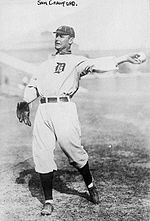
Sam Crawford retired in 1917 with 309 triples, the major league record.
In baseball, a triple is a hit in which the batter advances to third base in one play, with neither the benefit of a fielding error nor another runner being put out on a fielder's choice. Triples were more common in baseball's dead-ball era, when teams relied more on stolen bases and hit and run plays than on the home run. More distant fences in old ballparks, such as Pittsburgh's Forbes Field and Detroit's Tiger Stadium, also produced fewer home runs and more triples on well-hit balls. As a result, most of the players on this list have been retired for decades. Only two players in the top 50 all-time career triples leaders played after WWII (Stan Musial and Roberto Clemente), and there are no players in the top 50 who played after 1972.
In 2006, the Hardball Times lamented the decline of the 100-triple player, although three have joined the list since that time. Fangraphs, a statistical website, likewise noted the lack of modern 100-triple hitters in 2013. Of the 162 Major League Baseball players who have hit 100 or more triples, 69 are members of Baseball's Hall of Fame. (Full article...) -
Image 4
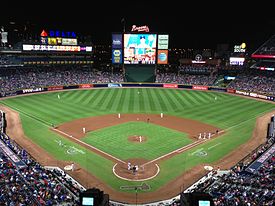
The Braves played nine Opening Day games at Turner Field, their home stadium from 1997 through 2016.
The Atlanta Braves are a Major League Baseball (MLB) franchise based in Atlanta. They play in the National League East division. They were based in Milwaukee and Boston before moving to Atlanta for the 1966 season. The first game of the new baseball season for a team is played on Opening Day, and being named the Opening Day starter is an honor, which is often given to the player who is expected to lead the pitching staff that season, though there are various strategic reasons why a team's best pitcher might not start on Opening Day. The Atlanta Braves have used 22 different Opening Day starting pitchers in their 57 seasons in Atlanta. The 22 starters have a combined Opening Day record of 15 wins, 23 losses and 19 no decisions. No decisions are only awarded to the starting pitcher if the game is won or lost after the starting pitcher has left the game.
Hall of Famer Phil Niekro holds the Atlanta Braves' record for most Opening Day starts, with eight. Greg Maddux had seven for the team and Julio Teherán was featured six consecutive times from 2014 to 2019. Rick Mahler had five while Tom Glavine and John Smoltz have each made four Opening Day starts for the Braves. Maddux has the record for most wins in Atlanta Braves Opening Day starts, with five. Mahler has the highest winning percentage in Opening Day starts (1.000), with four wins and no losses with one no decision. All of Mahler's four victories were shutouts, including three in consecutive years (1985 to 1987) by identical scores of 6–0. Niekro has the record for most losses in Atlanta Braves Opening Day starts, with six. (Full article...) -
Image 5
Aaron Cook, the 2007 Opening Day starter
The Colorado Rockies are a Major League Baseball (MLB) franchise based in Denver, Colorado. They play in the National League West division. The first game of the new baseball season for a team is played on Opening Day, and being named the Opening Day starter is an honor, which is often given to the player who is expected to lead the pitching staff that season, though there are various strategic reasons why a team's best pitcher might not start on Opening Day. The Rockies have used 20 different Opening Day starting pitchers in their 28 seasons. Since the Rockies' first season in 1993, the 20 starters have a combined Opening Day record of eleven wins, nine losses (11–9), and eight no decisions. No decisions are only awarded to the starting pitcher if the game is won or lost after the starting pitcher has left the game.
Eight Rockies pitchers have started on two Opening Days: Kevin Ritz, Darryl Kile, Mike Hampton, Jason Jennings, Aaron Cook, Ubaldo Jiménez, Jorge de la Rosa, and Jon Gray. Kile has the best Opening Day record with two wins and no losses. Armando Reynoso is the only Rockies pitcher to start on Opening Day in Colorado's former home of Mile High Stadium. Rockies starting pitchers have an Opening Day record of four wins, two losses, and one no decision when at home. With the exception of one lost game at Mile High Stadium, the other games were played at Colorado's current home stadium of Coors Field. On the road for Opening Day, Colorado starting pitchers have accumulated a record of seven wins, seven losses, and seven no decisions. The Rockies have a record of two wins and three losses on Opening Day for seasons in which they would later go on to participate in post-season play. (Full article...) -
Image 6

The former location of the Phillies Wall of Fame in Ashburn Alley at Citizens Bank Park
The Philadelphia Phillies Wall of Fame, officially known as the Toyota Phillies Wall of Fame for sponsorship reasons, is an exhibit located at Citizens Bank Park in Philadelphia, Pennsylvania. The exhibit is a collection of plaques that honor players and personnel who made significant contributions to the Philadelphia Phillies organization. Each person inducted into the Wall of Fame is honored with a metal plaque showing the person's face, their position with and years of service to the team, along with a summary of the person's notable accolades and contributions during their career. As of 2023, the Phillies have inducted 47 people (49 including the 1983 Centennial Team) into the Wall of Fame. (Full article...) -
Image 7
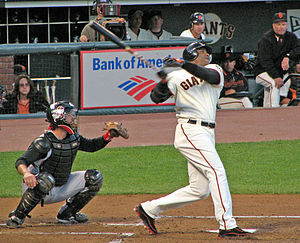
Barry Bonds, the all-time career home run leader in Major League Baseball, led the league in home runs twice including in 2001 when he set the record single-season mark
In baseball, a home run is scored when the ball is hit so far that the batter is able to circle all the bases ending at home plate, scoring himself plus any runners already on base, with no errors by the defensive team on the play. An automatic home run is achieved by hitting the ball on the fly over the outfield fence in fair territory. More rarely, an inside-the-park home run occurs when the hitter reaches home plate while the baseball remains in play on the field. In Major League Baseball (MLB), a player in each league[L] wins the home run title each season by hitting the most home runs that year. Only home runs hit in a particular league count towards that league's seasonal lead. Mark McGwire, for example, hit 58 home runs in 1997, more than any other player that year. However, McGwire was traded from the American League's (AL) Oakland Athletics to the National League's (NL) St. Louis Cardinals midway through the season and his individual AL and NL home run totals (34 and 24, respectively) did not qualify to lead either league.
The first home run champion in the National League was George Hall. In the league's inaugural 1876 season, Hall hit five home runs for the short-lived National League Philadelphia Athletics. In 1901, the American League was established and Hall of Fame second baseman Nap Lajoie led it with 14 home runs for the American League Philadelphia Athletics. Over the course of his 22-season career, Babe Ruth led the American League in home runs twelve times. Mike Schmidt and Ralph Kiner have the second and third most home run titles respectively, Schmidt with eight and Kiner with seven, all won in the National League. Kiner's seven consecutive titles from 1946 to 1952 are also the most consecutive home run titles by any player. (Full article...) -
Image 8

Roy Halladay (1995) is the only Blue Jays' first-round pick to be inducted into the Baseball Hall of Fame, and to win a Cy Young Award with the team.
The Toronto Blue Jays are a Major League Baseball (MLB) franchise based in Toronto, Ontario, Canada. They play in the American League East division. Since the Blue Jays' entrance into the league in 1977, the Blue Jays have selected 72 players in the first round. Officially known as the "First-Year Player Draft", the Rule 4 draft is MLB's primary mechanism for assigning amateur players from high schools, colleges, and other amateur clubs to its teams. The draft order is determined based on the previous season's standings, with the team possessing the worst record receiving the first pick. In addition, teams which lost free agents in the previous off-season may be awarded compensatory or supplementary picks. The First-Year Player Draft is unrelated to the 1976 expansion draft in which the Blue Jays initially filled their roster.
Of the 72 players picked in the first round by Toronto, 35 have been pitchers, the most of any position; 26 of them were right-handed, while nine were left-handed. 14 shortstops, 12 outfielders, four catchers and third basemen, and three first basemen have also been selected. The team has never drafted a player at second base in the first round. 38 players were drafted out of high school, while 31 came from four-year college programs and two from junior colleges. They have also drafted two players from Puerto Rico: Alex Ríos (1999) and Miguel Negrón (2000). (Full article...) -
Image 9There have been 23 managers in the history of the Los Angeles Angels Major League Baseball franchise. The Angels are based in Anaheim, California. They are members of the American League West division of the American League (AL) in Major League Baseball (MLB). The Angels franchise was formed in 1961 as a member of the American League. The team was formerly called the California Angels, the Anaheim Angels, and the Los Angeles Angels of Anaheim, before settling with the Los Angeles Angels.
Bill Rigney became the first manager of the then Los Angeles Angels in 1961, serving for just over eight seasons before being fired by Angels owner Gene Autry during the 1969 season. In terms of tenure, Mike Scioscia has managed more games and seasons than any other coach in franchise history. He managed the Angels to six playoff berths (2002, 2004, 2005, 2007, 2008, and 2009) led the team to a World Series championship in 2002, and won the Manager of the Year award in 2002 and 2009. With the Angels' 2009 Playoff appearance, Mike Scioscia became the first Major League Baseball manager "to guide his team to playoffs six times in [his] first 10 seasons." None of Scioscia's predecessors made it to the World Series. Dick Williams and Whitey Herzog, who served as an interim manager immediately before Williams, are the only Angels managers to have been inducted into the Baseball Hall of Fame. (Full article...) -
Image 10

Tony Mullane made five Opening Day starts for the Reds during the 1800s.
The Cincinnati Reds are a Major League Baseball franchise based in Cincinnati who play in the National League's Central Division. In their history, the franchise also played under the names Cincinnati Red Stockings and Cincinnati Redlegs. They played in the American Association from 1882 through 1889, and have played in the National League since 1890. The first game of the new baseball season for a team is played on Opening Day, and being named the Opening Day starter is an honor that is often given to the player who is expected to lead the pitching staff that season, though there are various strategic reasons why a team's best pitcher might not start on Opening Day. The Reds have used 76 Opening Day starting pitchers since they began play as a Major League team in 1882.
The Reds have played in several different home ball parks. They played two seasons in their first home ball park, Bank Street Grounds, and had one win and one loss in Opening Day games there. The team had a record of six wins and ten losses in Opening Day games at League Park, and a record of three wins and seven losses in Opening Day games at the Palace of the Fans. The Reds played in Crosley Field from 1912 through the middle of the 1970 season, and had a record of 27 wins and 31 losses in Opening Day games there. They had an Opening Day record of 19 wins, 11 losses and 1 tie from 1971 through 2002 at Riverfront Stadium, and they have a record of three wins and six losses in Opening Day games at their current home ball park, the Great American Ball Park. That gives the Reds an overall Opening Day record of 59 wins, 66 losses and one tie at home. They have a record of three wins and one loss in Opening Day games on the road. (Full article...) -
Image 11Jackie Robinson, the inaugural winner in 1947 and eventual namesake of the award
In Major League Baseball, the Rookie of the Year Award is given annually to two outstanding rookie players, one each for the American League (AL) and National League (NL), as voted on by the Baseball Writers' Association of America (BBWAA). The award was established in 1940 by the Chicago chapter of the BBWAA, which selected an annual winner from 1940 through 1946. The award became national in 1947; Jackie Robinson, the Brooklyn Dodgers' second baseman, won the inaugural award. One award was presented for all of MLB in 1947 and 1948; since 1949, the honor has been given to one player each in the NL and AL. Originally, the award was known as the J. Louis Comiskey Memorial Award, named after the Chicago White Sox owner of the 1930s. The award was renamed the Jackie Robinson Award in July 1987, 40 years after Robinson broke the baseball color line.
Nineteen players have been elected to the National Baseball Hall of Fame—Robinson, seven AL players, and eleven others from the NL. The award has been shared twice: once by Butch Metzger and Pat Zachry of the NL in 1976; and once by John Castino and Alfredo Griffin of the AL in 1979. Members of the Brooklyn and Los Angeles Dodgers have won the most awards of any franchise (with 18). Fred Lynn and Ichiro Suzuki are the only two players who have been named Rookie of the Year and Most Valuable Player in the same year, and Fernando Valenzuela is the only player to have won Rookie of the Year and the Cy Young Award in the same year. Sam Jethroe is the oldest player to have won the award, at age 32, 33 days older than 2000 winner Kazuhiro Sasaki (also 32). Luis Gil of the New York Yankees and Paul Skenes of the Pittsburgh Pirates are the most recent winners. (Full article...) -
Image 12
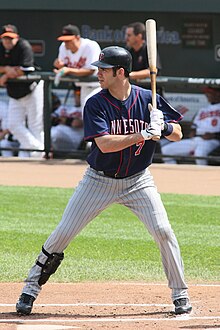
Joe Mauer, the Twins' first-overall selection in the 2001 draft, won an MVP, two Gold Gloves, three Silver Sluggers, and three batting titles.
The Minnesota Twins are a Major League Baseball (MLB) franchise based in Minneapolis, Minnesota. They play in the American League Central division. Since the institution of MLB's Rule 4 Draft, the Twins have selected 70 players in the first round. Officially known as the "First-Year Player Draft", the Rule 4 Draft is MLB's primary mechanism for assigning players from high schools, colleges, and other amateur clubs to its franchises. The draft order is determined based on the previous season's standings, with the team possessing the worst record receiving the first pick. In addition, teams which lost free agents in the previous off-season may be awarded compensatory or supplementary picks.
Of the 70 players picked in the first round by Minnesota, 30 have been pitchers, the most of any position; 22 of these were right-handed, while 8 were left-handed. Twelve outfielders were selected, while twelve shortstops, seven third basemen, four catchers, four first basemen and one player at second base were taken as well. Thirteen of the players came from high schools or universities in the state of California, and Florida follows with nine players. The Twins have drafted six players from Arizona, including five players from Arizona State University. (Full article...) -
Image 13

The 1980 Sounds set a team-best 97–46 (.678) record playing as the Double-A affiliate of the New York Yankees in the Southern League.
The Nashville Sounds Minor League Baseball team has played in Nashville, Tennessee, for 47 years since being established in 1978. As of the completion of the 2024 season, the club has played 6,566 regular-season games and compiled a win–loss record of 3,398–3,168–2 (.518). They have appeared in the postseason on 16 occasions in which they have a record of 49–44 (.527) in 93 games. Combining all 6,659 regular-season and postseason games, Nashville has an all-time record of 3,447–3,212–2 (.518).
Created as an expansion team of the Double-A Southern League (SL) in 1978, the Sounds played in this league through 1984. At the Double-A classification, Nashville was affiliated with Major League Baseball's Cincinnati Reds (1978–1979) and New York Yankees (1980–1984). The Sounds moved up to Triple-A in 1985 as members of the American Association (AA) before joining the Pacific Coast League (PCL) in 1998. They were placed in the Triple-A East (AAAE) in 2021, but this became the International League (IL) in 2022. At this level, they have been affiliates of the Detroit Tigers (1985–1986), Cincinnati Reds (1987–1992), Chicago White Sox (1993–1997), Pittsburgh Pirates (1998–2004), Milwaukee Brewers (2005–2014), Oakland Athletics (2015–2018), and Texas Rangers (2019–2020). The Sounds reaffiliated with the Milwaukee Brewers in 2021. (Full article...) -
Image 14
The Chicago White Sox celebrate after defeating the Minnesota Twins 1–0 to win the 2008 American League Central.
A tie-breaker was required in Major League Baseball (MLB) when two or more teams were tied at the end of the regular season for a postseason position such as a league pennant (prior to the introduction of the League Championship Series in 1969), a division title, or a wild card spot. Until 2022, both the American League (AL) and the National League (NL) used a one-game playoff format for tie-breakers, although the NL used a best-of-three series prior to 1969, when the leagues were split into divisions. As these tie-breaker games counted as part of the regular season and MLB teams (American League beginning in 1961, and National League beginning in 1962) have 162-game regular season schedules, the tie-breaker games were sometimes referred to as "Game 163". In 2022, as part of the new Collective Bargaining Agreement to end the 2021–22 Major League Baseball lockout, tiebreaker games were replaced with statistical tiebreaker procedures.
Sixteen tie-breakers – 12 single-game and four series – have been played in MLB history. In baseball statistics, tie-breaker games counted as regular season games with all events in them counted towards regular season statistics. This had implications on statistical races, such as when Matt Holliday won the batting average and runs batted in titles thanks in part to his performance in the 2007 tie-breaker. Home-field advantage for tie-breakers was determined by a coin flip through the 2008 season, after which performance-based criteria, starting with head-to-head record of the tied teams, were put in place. (Full article...) -
Image 15
The Silver Slugger Award has been awarded annually since 1980 to the best offensive player at each position in both the American League and the National League, as determined by the coaches and managers of Major League Baseball.
These voters consider several offensive statistics, including batting average, slugging percentage, and on-base percentage, as well as their "general impressions of a player's overall offensive value". They are not permitted to vote for players on their team. (Full article...)
More did you know
- ... that Dock Ellis pitched a no-hitter while under the influence of LSD?
- ... that Lorinda de Roulet is the first woman to direct the day-to-day operations of a Major League Baseball franchise?
- ... that Max Kepler-Rozycki received the largest signing bonus given to a European player by a Major League Baseball team?
- ... that Andrew Heaney led all college baseball pitchers in strikeouts during the 2012 season?
- ... that Johnny Evers alerted an umpire to Merkle's Boner?
Sports portals
Selected picture

| Credit: Paul Thompson |
Cornelius McGillicuddy, Sr. (December 22, 1862 – February 8, 1956), better known as Connie Mack, was an American professional baseball player, manager, and team owner. The longest-serving manager in Major League Baseball history, he holds records for wins (3,731), losses (3,948), and games managed (7,755), with his victory total being almost 1,000 more than any other manager.
Associated Wikimedia
The following Wikimedia Foundation sister projects provide more on this subject:
-
Commons
Free media repository -
Wikibooks
Free textbooks and manuals -
Wikidata
Free knowledge base -
Wikinews
Free-content news -
Wikiquote
Collection of quotations -
Wikisource
Free-content library -
Wikiversity
Free learning tools -
Wiktionary
Dictionary and thesaurus
More portals
- Pages with Spanish IPA
- Portals with triaged subpages from June 2018
- All portals with triaged subpages
- Portals with no named maintainer
- Automated article-slideshow portals with 51–100 articles in article list
- Automated article-slideshow portals with 501–1000 articles in article list
- Random portal component with 41–50 available subpages
- Automated article-slideshow portals with 201–500 articles in article list
- Random portal component with 11–15 available subpages
- Random portal component with 21–25 available image subpages

